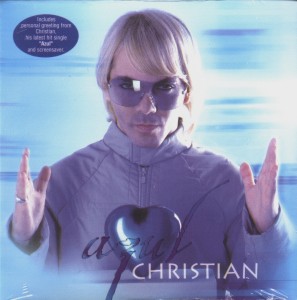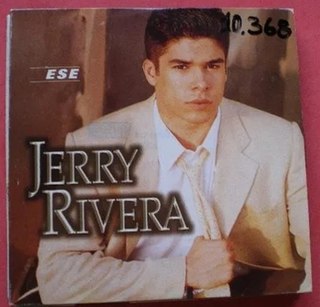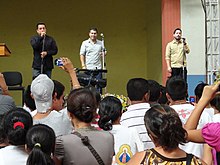
"No me enseñaste" is one of the most successful singles of Thalía to date, taken off her self-titled studio album Thalía. It was released as the second single in America, meanwhile it was released as the third one in Europe.

Thalía is the ninth studio album and third eponymous album by Mexican recording artist Thalía, released on July 8, 2003, by Virgin Records and EMI Latin. It is her first English-language album, and shares a title with Thalía's 1990 and 2002 Spanish-language albums. The album had a moderate success selling 750,000 in three months of release.

"I Need to Know" is a song by American singer Marc Anthony for his eponymous fourth studio album. It was released as the lead single from the album on August 16, 1999. Written and produced by Anthony and Cory Rooney, "I Need to Know" is a song about a man who longs to know how a woman feels about him. The song blends the musical styles of several genres, including R&B and Latin music; the instruments used include synthesized violin and piano sounds, timbales and congas. Anthony recorded a Spanish-language version of the song, translated by Angie Chirino and Robert Blades, titled "Dímelo".

"No Me Dejes de Querer" is a song by Cuban-American singer Gloria Estefan from her ninth studio album, Alma Caribeña (2000). The song was written by the artist along with Roberto Blades and her husband Emilio Estefan. The latter two also handled the song's production. It was released as the album's lead single on March 27, 2000, by Epic Records. "No Me Dejes de Querer" is a son cubano and murga song in which the narrator pleads her lover to never stop loving her. The song was met with mostly positive reviews, which found it to be an upbeat number.

"Cómo Me Duele Perderte" is a song by Cuban American singer Gloria Estefan from her ninth studio album, Alma Caribeña (2000). The song was written by Marco Flores with her husband Emilio Estefan and Roberto Blades handling its production. It was released as the album's second single by Epic Records on July 10, 2000. "Cómo Me Duele Perderte" is a salsa and bachata track that narrates the singer in pain of losing someone. The song was met with unfavorable reactions from music critics who criticized its arrangements and the singer's efforts. Commercially, the song topped the Billboard Hot Latin Songs and Tropical Airplay charts in the United States, while also peaking at number 12 on the Dance Club Songs chart in the same country and number eight in Spain. The accompanying music video was directed by Emilio, filmed in Miami, Florida, and features dramatic scenes of Estefan in front of a mirror remembering her former lover.

"Miente" is a song by Spanish singer Enrique Iglesias from his second studio album, Vivir (1997). The song was written and produced by Rafael Pérez-Botija. It was released as the third single from the album in 1997. An uptempo pop power ballad backed by a piano and percussion, the song deals with the singer being in denial about a relationship ending.

Lunada is the eleventh studio album by Mexican recording artist Thalía. It was released through EMI Latin on 24 June 2008 worldwide. Lunada is Thalía's first album since the release of the successful El Sexto Sentido in 2005 and since the birth of her first child. It was produced by the hit-maker Emilio Estefan and was described by Thalía as an album to "enjoy the summer". The album received generally favorable reviews.

"Entre el Mar y una Estrella" is a song by Mexican singer Thalía from her sixth studio album, Arrasando (2000). It was released as the album's lead single on 27 March 2000 by EMI Latin. The song was written and co-produced by Emilio Estefan and Marco Flores. The track is a pop ballad that deals with lost love and the song was dedicated to her former lover, Alfredo Díaz Ordaz, who died in 1993.

"Azul" (transl. "Blue") is a song by Mexican singer Cristian Castro from his seventh studio album of the same name (2001). The song was co-written by brothers Kike and Gustavo Santander and produced by Kike, Andrés Munera, Fernando "Toby" Tobón. It is a pop rock power ballad in which the singer compares love to the color blue. The track was released on as the lead single from the album by BMG US Latin on 3 May 2001. A music video for "Azul" was directed by Pedro Torres and features Castro in a beach, house, and a nightclub with friends and premiered on 6 June 2001.

"Ese" is a song performed by Puerto Rican-American singer Jerry Rivera from his ninth studio album De Otra Manera (1998). The song became his first #1 on the Hot Latin Tracks chart and fifth overall on the Tropical Airplay chart. It was acknowledged as an award-winning song at the 2000 BMI Latin Awards. Two versions of the song were recorded, one in salsa and the other a bolero. The success of releasing two versions of the song to Latin radio stations led to Sony Discos having their artists record multiple versions of the same song. José A. Estévez Jr. of AllMusic felt that Rivera "demonstrates with conviction" in the song. Eliseo Cardona of El Nuevo Herald stated that the song "can be taken as a signal of alert It shows in any case that it was already time to get out of the monotony accumulated by his discography After listening to the song it is force majeure to recognize that the latter was fulfilled." The song was later featured as the main theme for the Mexican telenovela Mirada de mujer (1998). The music video for the song featured the ballad version and was directed by Steve Bielo.

"Júrame" is a song by American singer Gisselle from her seventh studio album, Voy a Enamorarte (2000). The song was written and produced by Colombian musician Kike Santander. It was recorded twice, as a pop ballad and a merengue track, respectively. In the lyrics, it deals with love's ambition. Both versions were released as a single from the album by BMG US Latin in 2000. A music video for the ballad version was filmed in Florida.
"Que Alguien Me Diga" is a song by Puerto Rican singer Gilberto Santa Rosa from his 12th studio album, Expresión (1999). It was written by Omar Alfanno with José Lugo and the artist handling its production. It is a salsa track in which the singer is searching for unconditional love. Santa Rosa would later record a ballad version. An accompanying music video features the singer in a dark room surrounded by female musicians. Both versions of the song received airplay on Latin radio stations.













